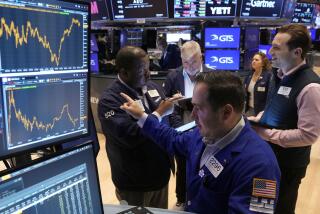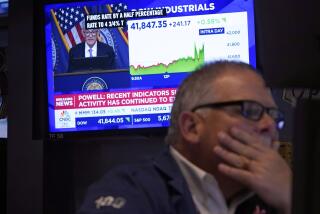Dollar Takes Sharpest Fall in 3 1/2 Years
- Share via
The U.S. dollar suffered its sharpest plunge in 3 1/2 years Wednesday as European central banks dumped as much as $1.5-billion worth of American currency on foreign exchange markets in an effort to halt a sharp run-up in the value of the dollar during the past three weeks.
The massive intervention by the foreign central banks, one of the largest coordinated actions against the dollar ever, reflects their concern that the dollar’s rise has been excessive and potentially detrimental to economic stability.
Intervention by the central banks came one day after Federal Reserve Board Chairman Paul A. Volcker told a House committee that foreign central bankers had not practiced intervention “forcefully enough” to have an impact.
Swiss Not Involved
All major European central banks except Switzerland’s participated in the action by selling off dollars to lower the price of the currency. West Germany’s Deutsche Bundesbank alone dumped as much as $1 billion on foreign exchange markets, traders said.
The Federal Reserve said the dollar’s value against 10 major foreign currencies, weighted for international trade, fell 1.9% from Tuesday’s level. That was the sharpest decline since the dollar lost 2.01% of its value on Aug. 12, 1981.
The dollar had set records on 16 out of 18 business days this month.
“It’s quite a substantial move,” said Ted Craver, vice president and manager of foreign exchange for Los Angeles-based First Interstate Bank Ltd. The central banks “had to do something,” he added.
“The market needed this,” said Timothy F. Hurley, first vice president and manager of foreign-exchange operations at Bank of Boston. “The market had been too disorderly during the past two to three weeks.”
Many European leaders and economists believed that the recent surge has made international trade more difficult because corporations could not accurately predict the value of currencies.
They also hope to prevent the dollar from rising so spectacularly high that it would become vulnerable to a massive fall later. A rapidly falling dollar could cause investors to pull massive amounts of funds out of the United States, thus triggering an American recession that could spread to other nations.
The rising dollar--caused in part by high interest rates, a strong economy and political stability in the United States--so far has encouraged foreign investors to take their funds out of foreign economies and to put them into the United States.
The high dollar also has hurt the U.S. economy, by making American goods more expensive relative to foreign goods. As American exports have been hurt and imports helped, the U.S. trade deficit has continued to grow to record levels.
While the strong dollar is believed to have helped suppress inflation by encouraging low-priced imports, a number of economists now contend that efforts to stem the dollar’s rise could create renewed inflationary pressures. To hold down the value of dollar, the Federal Reserve has had to pump more dollars into the economy than it would have otherwise, they say. The presence of more dollars in circulation generally leads to higher inflation.
Volcker Informed
Foreign-exchange analysts speculated that Volcker’s statement might have indicated to foreign central banks that the Federal Reserve would not object to more forceful actions. Because of the importance of the Federal Reserve in world foreign exchange markets, any intervention by central banks on such a massive scale could not have taken place without Volcker’s knowledge and concurrence, analysts said.
Foreign central banks in recent months have tried to stem the dollar’s rise by raising their own interest rates or by selling dollars. But some economists suggest that the actions, by not being strong enough, may have actually backfired by convincing traders that foreign central banks could not effectively control the dollar.
By the end of the European trading day, the dollar had lost more than 14 pfennigs against the West German mark, nearly 43 centimes against the French franc and 105 Italian lire. There are 100 pfennigs to a mark and 100 centimes to the franc.
Foreign-exchange experts said Wednesday’s actions are likely to stabilize the value of the dollar, at least for the next few weeks. In fact, after the dramatic fall earlier in the day, the value of the dollar steadied in late trading Wednesday.
Such a stabilization was due anyway, they said, because the dollar had risen so much in the past three weeks.
Correction ‘Long Overdue’
“A correction, even without intervention, was long overdue,” said Ephraim Sella, an assistant vice president at the New York-based BankAmerica International, the foreign-exchange trading arm of San Francisco-based BankAmerica Corp.
However, experts said, the value of the dollar is likely to again rise, because the strong U.S. economy and high U.S. interest rates continue to make this country an attractive place to invest.
Although a declining dollar generally is accompanied by rising gold prices, the metal turned in a mixed performance Wednesday. Bullion climbed $5 in Zurich to a late bid of $290.50 an ounce, while rising $2.80 in London to close at $290 an ounce. On New York’s Commodity Exchange Inc., gold for March delivery slipped 20 cents to $288 an ounce but still was above Monday’s 5 1/2-year low of $282.
More to Read
Inside the business of entertainment
The Wide Shot brings you news, analysis and insights on everything from streaming wars to production — and what it all means for the future.
You may occasionally receive promotional content from the Los Angeles Times.










